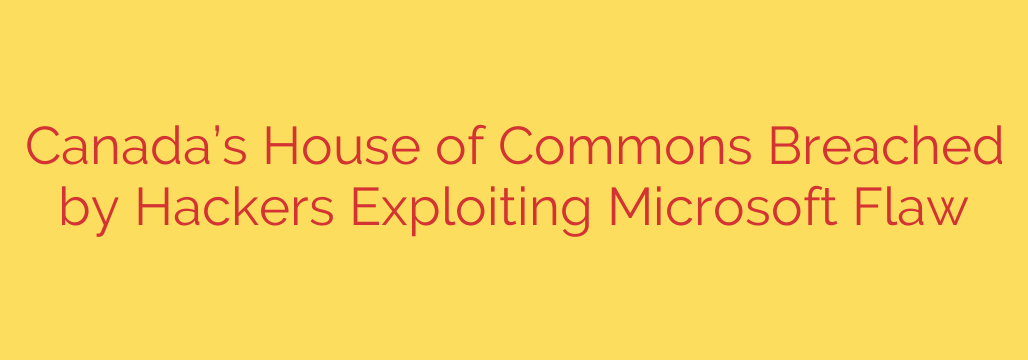
Canadian Parliament Hit by Cyberattack: What You Need to Know About the Microsoft Vulnerability
In a stark reminder of the ever-present threat of cyber warfare, Canada’s House of Commons recently fell victim to a significant security breach. Attackers successfully compromised the institution’s IT infrastructure by exploiting a critical vulnerability in Microsoft Exchange, the widely used email and calendaring server software. This incident underscores the sophisticated challenges facing even the most secure government bodies and serves as a crucial wake-up call for organizations of all sizes.
The breach prompted an immediate and decisive response from parliamentary IT administrators, who worked to contain the intrusion and assess the damage. While details about the specific data accessed remain confidential, the attack targeted the core digital communications network used by Members of Parliament and their staff. This event highlights a critical truth in modern cybersecurity: no target is off-limits, and government institutions are prime targets for espionage and disruption.
The Root Cause: A Global Microsoft Flaw
It is essential to understand that this attack was not the result of a simple password guess or a phishing email. Instead, the hackers leveraged a known, high-severity flaw within Microsoft’s software. This was not an isolated incident targeting only the Canadian government; the same vulnerability has been actively exploited by cybercriminals and state-sponsored groups around the world to attack thousands of organizations in the public and private sectors.
The vulnerability allows malicious actors to gain unauthorized access to email servers. Once inside, they can potentially:
- Read, steal, or delete sensitive emails and attachments.
- Harvest credentials to move deeper into the network.
- Install ransomware or other malware to disrupt operations.
- Establish a persistent presence for long-term surveillance.
The fact that a government institution was breached using a publicly known vulnerability demonstrates the critical importance of timely software updates and patch management.
Key Lessons and Actionable Security Tips for Your Organization
This high-profile attack offers valuable lessons for businesses, non-profits, and government agencies alike. Cybercriminals often use the same tactics against targets of all sizes. Here are essential steps you can take to fortify your defenses against similar threats.
1. Prioritize Urgent Patch Management
The single most important defense against this type of attack is to apply security patches as soon as they are released by a vendor. Hackers thrive in the gap between a patch release and its application. Establish a clear and rapid process for testing and deploying critical security updates to all systems, especially public-facing ones like email servers.
2. Implement Multi-Factor Authentication (MFA)
MFA adds a powerful layer of security that can prevent unauthorized access even if a password is stolen. By requiring a second form of verification—such as a code from a mobile app—you make it significantly harder for attackers to compromise accounts. Ensure MFA is enabled on all critical accounts, especially for remote access and administrative privileges.
3. Assume You Are a Target
Do not operate under the assumption that your organization is too small or insignificant to be targeted. Automated scanning tools constantly search the internet for vulnerable systems, regardless of who owns them. Adopting a proactive security posture and assuming a breach is possible is the first step toward building a resilient defense.
4. Enhance Network Monitoring and Segmentation
You cannot stop a threat you cannot see. Invest in robust monitoring tools to detect unusual activity on your network, such as abnormal data transfers or access from unexpected locations. Furthermore, segmenting your network can help contain a breach, preventing an intruder from moving freely from a compromised system to your most critical assets.
The cyberattack on Canada’s House of Commons is more than a news headline; it is a case study in modern digital risk. By learning from this incident and taking proactive steps to secure their own systems, organizations can better protect themselves from a volatile and ever-evolving threat landscape.
Source: https://securityaffairs.com/181155/hacking/hackers-exploit-microsoft-flaw-to-breach-canada-s-house-of-commons.html








